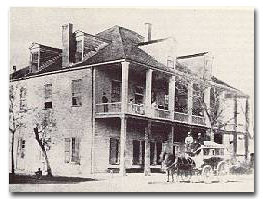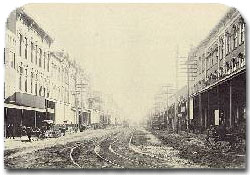THE DECADE OF RAILROAD BUILDING (1850-1860)
The seventh United States census set the population of the 31 states of the union at 23,191, 876, a total somewhat less than the net increase in the nations' population from 1850 to 1860. In that earlier census, the population of Texas was 212,592, or about one-ninth the net increase in the state's population from 1850 to 1860. The federal census of 1850 reported 2,396 Houstonians in a nine-square-mile city, with 4,668 in the 1,747-square-mile area of Harris County, or about one-hundredth of the net increase of population in the city and county from 1850 to 1860. Eight of Texas' counties ranked ahead of Harris County in population in 1850.
This decade brought growing conflict over slavery and states' rights, a cholera epidemic through the Middle West and a yellow fever epidemic with 5,000 deaths in New Orleans, and the gold rush to California. "Bloomers" were introduced by Mrs. Amelia Bloomer, editor of a woman's rights magazine, women were hired for the first time as department store clerks and as waitresses, and there was a strong trend toward women teachers in the public schools. The decade brought firsts in overland mail delivery, electric fire-alarm systems, "fireproof" buildings, public libraries, elevators, and the first cable message across the Atlantic. It brought horse cars to the streets of New York, Boston, Philadelphia and Chicago, and a steam interurban between Boston and Cambridge; as well as the express from St. Joseph, Missouri, to Sacramento, California. The first oil business in the United States was started with the formation of the Pennsylvania Rock Oil Company. Gail Borden, the one-time Texas publisher and surveyor who platted the original street plan for Houston, invented evaporated milk and developed a meat biscuit, primarily for those on wagon trains to the west. Santa Anna restored his dictatorship in Mexico in 1853, but was finally overthrown by Mexican reformers two years later.
 Texas and the West made rapid gains in population and wealth during this decade. While several new towns were started, the main population increase in Texas came with the settlement of new rural areas, and eighty-nine new counties were created between 1850 and 1860. The Texas permanent school fund, now one of the greatest educational endowments in the nation, was established during this period. Encouraged by state grants of sixteen sections of land together with a loan of $6,000 per mile, eleven railroad companies built 451 miles of track prior to 1860.
Texas and the West made rapid gains in population and wealth during this decade. While several new towns were started, the main population increase in Texas came with the settlement of new rural areas, and eighty-nine new counties were created between 1850 and 1860. The Texas permanent school fund, now one of the greatest educational endowments in the nation, was established during this period. Encouraged by state grants of sixteen sections of land together with a loan of $6,000 per mile, eleven railroad companies built 451 miles of track prior to 1860.
The Houston Chamber of Commerce recognized the importance of transportation generally and particularly the connection of railroads to the Port of Houston, and was instrumental in the beginning of the first railroad as well as the first telegraph line in Texas. The Buffalo Bayou, Brazos & Colorado Railroad was organized in 1847, but construction was not started for four years, and the first 20 miles of railroad in Texas and the second railroad west of the Mississippi River was inaugurated by this company in 1853. The next Texas railroad was started by the Galveston & Red River Railway Company, which was renamed Houston & Texas Central Railway Company after the Houston Chamber of Commerce was influential in bringing it to Houston.
Houston's first manufacturer was Alexander McGowen, for whom McGowan Street was named, whose iron foundry became an industrial showplace in the community. Tom Whitmarsh built a large warehouse for cotton, hides and other commodities on Buffalo Bayou just east of Main Street. "King Cotton" became the familiar phrase throughout the South, and cotton was truly king of the Houston-area economy. Cotton came by ox-wagon from surrounding plantations, particularly in the Brazos River bottoms, and more than 10,000 bales piled up in the Houston warehouses. The "Morning Star" announced that a cotton grower had "engaged with a commercial house in this city to deliver 6,000 bales of cotton." Agricultural products and lumber ranked as the port's principal exports while imports were mostly for the year at 60,000 bales.
 The Port of Houston had become so important by 1853 that the Texas Legislature, urged by the Chamber of Commerce, appropriated $4,000 to improve the channel of Buffalo Bayou. The wood-burning "General Sherman" puffed its way to pull the first train to Stafford's Point over the Buffalo Bayou, Brazos & Colorado Railroad. By 1856, Main Street was being resurfaced with shell; trains began to roll between Houston and Galveston over the Galveston, Houston & Red River Railroad. The City of Houston built the Tap Railroad to Pierce Junction. A city-owned dredge deepened Buffalo Bayou for steamboats, and prosperity seemed sure and permanent.
The Port of Houston had become so important by 1853 that the Texas Legislature, urged by the Chamber of Commerce, appropriated $4,000 to improve the channel of Buffalo Bayou. The wood-burning "General Sherman" puffed its way to pull the first train to Stafford's Point over the Buffalo Bayou, Brazos & Colorado Railroad. By 1856, Main Street was being resurfaced with shell; trains began to roll between Houston and Galveston over the Galveston, Houston & Red River Railroad. The City of Houston built the Tap Railroad to Pierce Junction. A city-owned dredge deepened Buffalo Bayou for steamboats, and prosperity seemed sure and permanent.
Although the Galveston, Houston & Henderson railroad was started in 1854, most of the merchandise continued to move by more primitive means. During that year the " Houston Telegraph " estimated that 38,000 bales of cotton had been freighted to Houston. In May, 1855, the " Telegraph " announced that " not less than 4,000 bales of cotton has arrived in this city in the last two weeks on ox-wagons, giving employment to thousands of oxen and 670 wagons and drivers." The same newspaper reported that at least 200 wagon-loads of other merchandise had arrived.
Railroads, first built to serve an agricultural economy, helped immeasurably in Houston's growth to greatness. The official seal of the City of Houston encircles an ancient locomotive and a plow. This may be the original seal authorized on Friday 24, 1840, since President Lamar had signed a bill a year earlier granting a charter to a railroad that later had financing difficulties and was not built. Railroads continued to play a vital role in the building of Houston, and the Chamber of Commerce years later was to characterize Houston at the city " Where Seventeen Railways Meet the Sea."
The bright hope of the future was clouded in 1859 when a ranging fire roared through the city, ravaging homes and businesses. The smoke finally cleared away, but the gloom that followed deepened as an awesome cloud over the stricken city. But once again, under coordinated constructive programs of rehabilitation. Like the legendary phoenix bird, Houston rose from its own ashes determined to soar to an even greater destiny.






